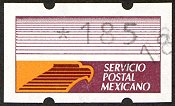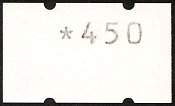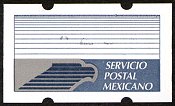| MEXICO. ATMs and variable value stamps. Introduction |
|
 |
| 1990. KLÜSSENDORF distributors |
In 1990, the Servicio Postal Mexicano (Mexican Postal Service) - SEPOMEX decided to put to the test the ATM vending machines manufactured by the Klüssendorf company.
Since installing its first distributors in Germany in the early '80s, the German company had been promoting its postal equipment around the world, and from the early '90s some European, American and Asian postal administrations had tested and, in some cases, decided on the installation of ATM distributors manufactured by Klüssendorf.
So in this setting, SEPOMEX started a pilot scheme, from April 16th 1990, using 2 type 696 Klüssendorf ATM vending machines, for use by the public and which accepted payment by coins, and 2 type 829 Klüssendorf stamp printers, for use only by postal staff. All these items of equipment were installed in the post office and public areas of the Benito Juárez International Airport in Mexico City.
The Klüssendorf 696 distributors, installed in Mexico, had 13 buttons pre-programmed with the main franking values on the installation date. 500, 700, 900, 1000, 1400, 1500, 1600, 1700, 2000, 2100, 2200, 3100 and 4000 pesos. They also had another button for printing the face value according for the amount paid, so that users could obtain ATMs with any face value between 5 and 9995 pesos. Payment was only possible with coins, and no receipts were printed. Unlike the Frama distributors, these machines were not adjusted for the new currency, the nuevo peso (N$), which was valid from 1993.
For ATM issues, the Klüssendorf machines used rolls of gummed labels. These were pre-printed with a design of a horizontal striped pattern in the upper half, used for the 4-digit face value printing, whilst the SEPOMEX logo appeared in the bottom half.
The feed mechanism used roller traction for the rolls of 2,000 labels, each of which includes two circular holes, resulting in each printed label having two semicircles at the top and two in the lower part. Once cut and issued by the machine, the stamp size was 43 x 25.5 mm.
The printing of the face value on the ATMs was mechanical, with black ink, and used a print head which had 4 wheels of digits. |
 |
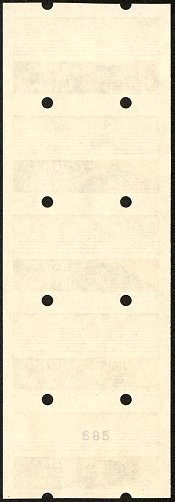 |
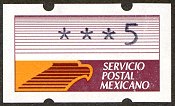 |
The first labels, used from April 16th 1990, were printed in 2 colours, brown and orange. The gum is yellowish and shiny. |
 |
| The rolls were manufactured in Germany and supplied along with equipment. As can be seen in the picture above, every fifth ATM has a faint pre-printed control number on the back that indicated the number of stamps remaining on the roll. |
| Two types of paper were used for the manufacture of the rolls, one of which had a fluorescent coating. This paper is very easy to identify, when seen under a UV light. |
 |
There are, therefore, ATMs of this design with 2 paper types, fluorescent and normal. It is also possible to find varying degrees of fluorescence, as a result of the manufacturing process and the condition of the stamp. For example, used off-paper stamps may have lost some of the luminescent coating during the soaking process.
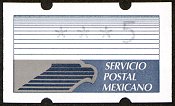 |
After the testing phase, and coinciding with the entry into service of the new Frama distributors, new rolls of labels were used in the Klüssendorf machines from June 10th 1992. |
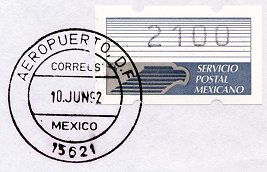 |
| The design is identical to the previous labels, but used dark blue-grey and grey colours. The new rolls were manufactured by a local company, on high quality white gummed paper, glossy gum, and without the control number on the back. |
| For this design it is possible to find 2 types of labels. |
| The most common paper (right picture) has more weight, glossy gum, and does not react under UV light. There are also rare ATMs printed on lighter weight luminescent paper, and opaque gum (left picture). |
 |
There are ATMs of both designs with different printing errors. Some of them are due to equipment faults producing partial or multiple imprints, whilst others have reversed imprints or have been printed on the gummed side of the label. These latter items have been created only for collecting purposes and are possible only with the cooperation and complicity of those responsible for the equipment.
The Klüssendorf machines were in service until 1995, but some worked discontinuously after that date. One of the 829 printers, used in the postal branch of Lomas de Chapultepec in Mexico City, was definitely out of service in mid-2002.
Following the initial pilot scheme with Klüssendorf equipment, SEPOMEX launched a tender, in 1991, for the supply and installation of new ATM vending machines, to be installed in public areas (mainly shopping centres and transportation stations) in Mexico City. The German company Klüssendorf took part in the tender, but did not accept the bidding conditions. The winner was the Swiss company Frama, which through a newly created representation company in Mexico, submitted the best offer.
So 90 ATM distributors - type FE 1410 (right picture), manufactured by the Swiss Frama, were installed, from June 10th 1992, around Mexico City. |
 |
| The new distributors were installed in roomy booths, were well-marked, included information on current postage rates, and had a double mailbox at the bottom for the franked postal items (see pictures at the end of the study). One of them was a buzón expresso or expresso mailbox, a new SEPOMEX domestic mail service (right image, special postmark) which pledged to deliver local mail within a maximum of 24 hours, and 3 days for other locations. |
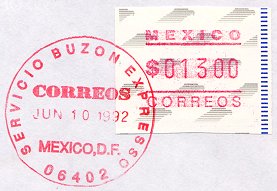 |
 |
In these distributors, the user could obtain variable value stamps or ATMs of any face value between 50 and 99,950 pesos, in steps of 50 pesos. The machines accepted 4 types of coins: 50, 100, 500 and 1000 pesos.
The new currency, the nuevo peso (N$) -equivalent to 1,000 pesos- was introduced from January 1st 1993, although the distributors were not adjusted to the new currency, and the print impression was not changed, until mid-1994. From March 1994, the distributors accepted 8 different types of older and new coins: 0.10, 0.50, 1, 2 and 5 N$, and coins of 100, 500 and 1000 pesos, and could issue ATMs with face values of between 0.10 N$ and 99.90 N$, in steps of 0.10 N$.
In all cases, the change or credit remaining, after payment and issue of the required stamp(s), was by issuing another ATM. |
In addition to these public use distributors, 30 Frama SG stamp printers (right picture) were installed from June 17th 1992 in some post offices, only for use by postal employees. These machines could print ATMs with any face value between 1 and 99,999 pesos, and later between 0.01 N$ and 999.99 N$.
This type of table-top stamp printer was being used since the mid-70s in other countries, but they were usually used for the immediate franking of the postal pieces handed in at the counter, and the stamp included information about the post office and the shipment date: so, was not an ATM. |
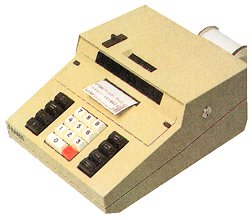 |
Both types of machines used the same type of gummed paper, manufactured by the Swiss printer PTT - La Poste, although differing both in size and fixed printing impression. The paper is an off-white colour with matt gum and a fluorescent coating. The dark grey security background includes a continuous pattern of the eagle's head -the SEPOMEX emblem-, and has a vertical strip of 1.5 mm. width, in blue, on the right with 29-30 horizontal bars. They react under UV light, and a few fibres can be seen on the back.
The impression made by Frama distributors (left pictures, below), in red, includes the words MEXICO at the top and CORREOS at the bottom, with the 5-digit face value preceded by the symbol of the peso ($) in the middle, between 2 horizontal lines.
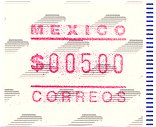 |
The publically used distributors issued ATMs sized 40 x 32 mm. (left), while the ATMs printed on table-top stamp printers are larger, 72 x 32 mm. (right). |
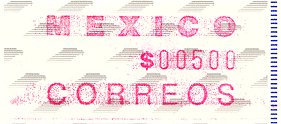 |
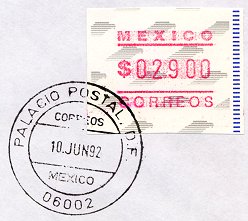 |
The impression made by Frama stamp printers (right pictures), also in red, included the words MEXICO at the top and and CORREOS at the bottom, and the 5-digit face value in the middle, displaced to the right and preceded by the symbol of the peso ($). |
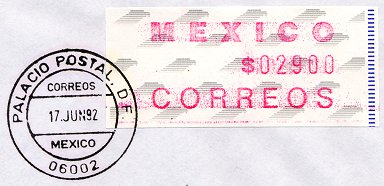 |
| Details of covers with the first day postmarks. |
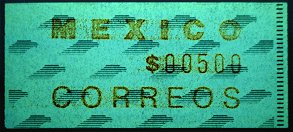 |
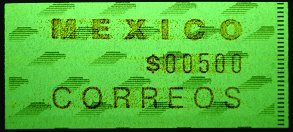 |
| All the rolls of labels, produced by the printer of La Poste (Switzerland), have a fluorescent coating which reacts yellow-green under ultraviolet light, although it is possible to recognize two important grades or variations in the fluorescent treatment. Both types of coils were used indiscriminately and at the same time and in fact, its easy to find sets with mixed ATMs. |
On January 1st 1993, the Bank of Mexico introduced a new currency, the Nuevo peso mexicano (N$), equivalent to 1000 pesos. For over 1 year, the Frama distributors continued working, issuing ATMs in the former currency. From March 1994 the machines were adapted to the new currency, providing them with a new coin mechanism which accepted up to 8 different types of coins, and modifying the design of the impression (pictures below, at left): Now MEXICO and CORREOS are smaller and, in the centre, the 4-digit face value with a decimal point. On both sides, the solidarity logo, a design introduced by the Carlos Salinas de Gortari government, and all the printing is inside a rectangle.
The table-top stamp printers were also adjusted. The new printing impression (pictures below, at right) includes the words MEXICO and CORREOS at the top and the bottom, is a smaller size. In the centre, displaced to the right, is the 5-digit face value, with decimal point and surrounded with the solidarity logo on 3 sides. All of the impression is inside a rectangle, open at the left.
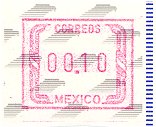 |
With the introduction of the new currency, the minimum face values obtainable was 0.10 N$ from the distributors, and 0.01 N$ from the stamp printers ... |
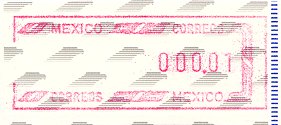 |
 |
...
although there are labels with a zero face value, issued as a printing test for those in charge of the equipment. |
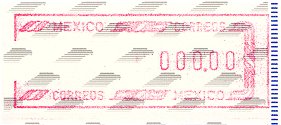 |
| With the same printing impression there are labels with no postal value, issued for only for collectors by a distributor using rolls of white test paper ... |
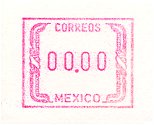 |
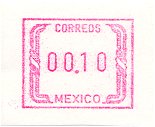 |
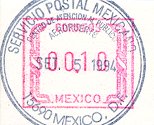 |
| and the usual supposed printing errors (inverted imprints and on the back of the labels). A collection of curious varieties only possible with the cooperation of those responsible for the machines. |
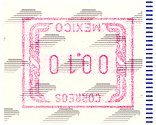 |
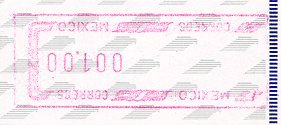 |
In the ensuing years, a local printing company made some reprints of the gummed paper rolls used by both Frama machine types, with the same pre-printed background security design, but with some variations on the original. The new rolls were manufactured using non-fluorescent paper and all the ATMs issued with these reprints have 32 blue horizontal bars in the right vertical strip, compared with 29-30 in the original paper.
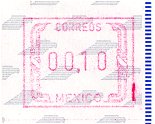 |
It is possible to distinguish different colour schemes in the background pattern, ranging from light grey to grey-green or dark grey, ... |
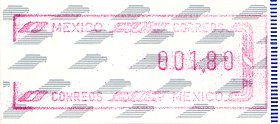 |
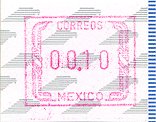 |
variations in the size of the vertical blue strip at the right (1.5 mm. on the images above, and 2 mm. on the lower ones), as well as the position and colour, different gum type, ... |
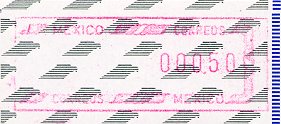 |
There are ATMs issued on these paper reprints having a double row of eagles that does not follow the original security background pattern:
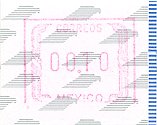 |
This is a cyclical error, produced by a misalignment in the ends of the printing plate, a similar case that occurred, for example, with the Spanish Frama issue. |
 |
 |
Left: original paper, fluorescent.
Right: later reprintings on non fluorescent paper. |
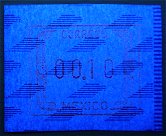 |
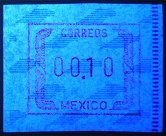 |
An in-depth study of the various reprints of the Frama papers of Mexico and their imprint varieties and errors, is beyond the scope of this article, and will be examined in another study.
| Despite the careful planning and installation of these expendedoras de estampillas (stamp distributors) in busy public areas, such as the International Airport (right picture), metro stations (Moctezuma station, central image), bus terminals, shopping centres,… problems arose. A lack of proper maintenance of equipment plus a low acceptance of this new postage system by users, and a gradual degradation of equipment occurred, resulted in many machines gradually being taken out of service. This process culminated in 2004 with the withdrawal of all Frama machines. |
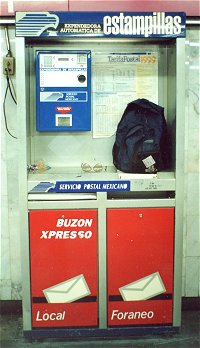 |
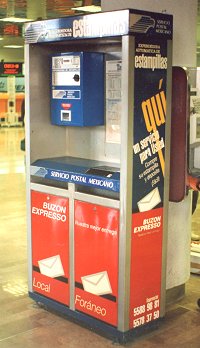 |
With the collaboration of Alberto Acosta, Mexico. Photos by Alfredo Urbina, Mexico.
2006. The Sistema Integral de Operación
- Integral Operation System (SIO)
Read article >>> |
 |
ATM Web - Spain and Latin American Postal Services: http://www.ateeme.net
© J. Jove - M. Sans. ATEEME. Variable value stamps study group. All rights reserved
This page was created in 2000 and last updated:
21.07.09
. English edition rewritten by S. Goodman (14.04.2009)
|










